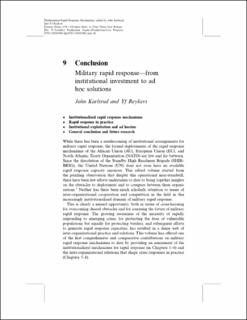| dc.contributor.author | Karlsrud, John | |
| dc.contributor.author | Reykers, Yf | |
| dc.date.accessioned | 2023-03-07T10:07:16Z | |
| dc.date.available | 2023-03-07T10:07:16Z | |
| dc.date.created | 2018-12-27T12:34:20Z | |
| dc.date.issued | 2019 | |
| dc.identifier.isbn | 9781138543980 | |
| dc.identifier.uri | https://hdl.handle.net/11250/3056371 | |
| dc.description.abstract | While there has been a mushrooming of institutional arrangements for military rapid response, the formal deployments of the rapid response mechanisms of the African Union (AU), European Union (EU), and North Atlantic Treaty Organization (NATO) are few and far between. Since the dissolution of the Standby High Readiness Brigade (SHIRBRIG), the United Nations (UN) does not even have an available rapid response capacity anymore. This edited volume started from the puzzling observation that despite this operational near-standstill, there have been few efforts undertaken to date to bring together insights on the obstacles to deployment and to compare between these organizations. Neither has there been much scholarly attention to issues of inter-organizational cooperation and competition in the field in this increasingly institutionalized domain of military rapid response. This is clearly a missed opportunity, both in terms of cross-learning for overcoming shared obstacles and for assessing the future of military rapid response. The growing awareness of the necessity of rapidly responding to emerging crises, for protecting the lives of vulnerable populations but equally for protecting borders, and subsequent efforts to generate rapid response capacities, has resulted in a dense web of inter-organizational practice and relations. This volume has offered one of the first comprehensive and comparative contributions on military rapid response mechanisms to date by providing an assessment of the institutionalized mechanisms for rapid response (in Chapters 1–4) and the inter-organizational relations that shape crisis responses in practice (Chapters 5–8). | |
| dc.description.abstract | Conclusion: Military rapid response—from institutional investment to ad hoc solutions | |
| dc.language.iso | eng | en_US |
| dc.relation.ispartof | Multinational Rapid Response Mechanisms: From Institutional Proliferation to Institutional Exploitation | |
| dc.rights | Attribution-NonCommercial-NoDerivatives 4.0 Internasjonal | * |
| dc.rights.uri | http://creativecommons.org/licenses/by-nc-nd/4.0/deed.no | * |
| dc.subject | EU | |
| dc.subject | NATO | |
| dc.subject | FN | |
| dc.subject | UN | |
| dc.subject | Fredsoperasjoner | |
| dc.subject | Peace operations | |
| dc.title | Conclusion: Military rapid response—from institutional investment to ad hoc solutions | en_US |
| dc.type | Chapter | en_US |
| dc.description.version | acceptedVersion | |
| dc.subject.nsi | VDP::Internasjonal politikk: 243 | |
| dc.subject.nsi | VDP::International politics: 243 | |
| dc.source.pagenumber | 177-189 | en_US |
| dc.identifier.cristin | 1647351 | |
| cristin.unitcode | 7471,13,0,0 | |
| cristin.unitname | Fred, konflikt og utvikling | |
| cristin.ispublished | true | |
| cristin.fulltext | postprint | |
| cristin.qualitycode | 2 | |

